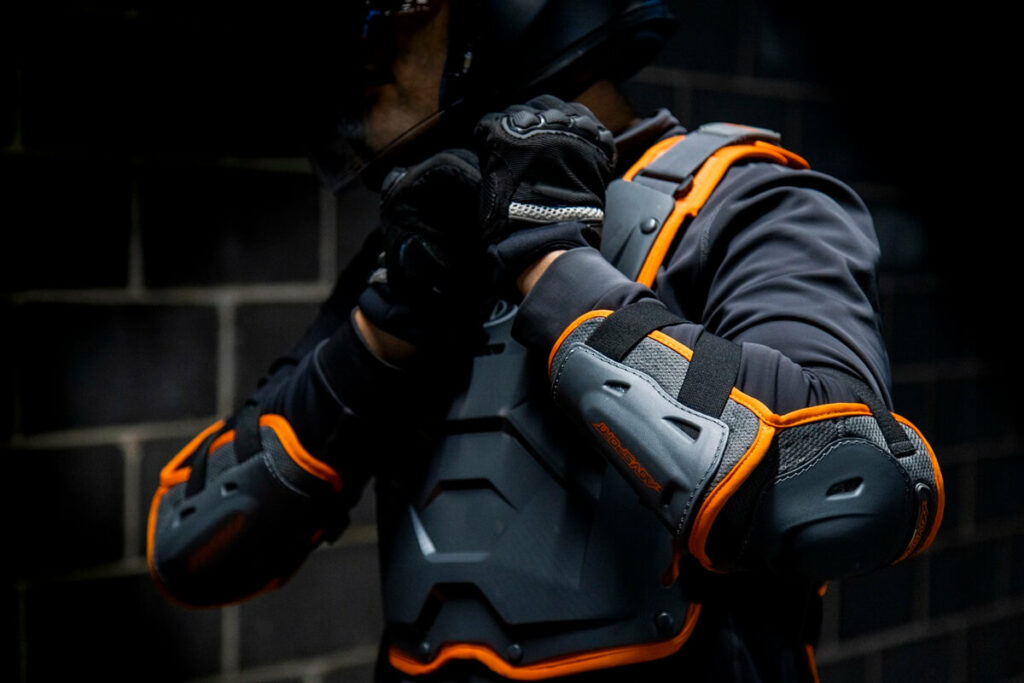As a motorcycle rider, you should understand that safety is the foremost priority during rides, hence the need to put on motorcycle armor and other safety gear. However, it can be really complex to understand the safety ratings and standards that govern this gear.
Motorcycle armor CE rating, among other safety requirements, has been a complex topic of discussion among riders. While a few riders have ample knowledge of what the CE rating means for motorcycle gear, most struggle to grasp the full concept behind it.
In this article, I am going to simplify everything you need to know about motorcycle armor CE rating: You will understand what CE means for gear, why it is important when shopping for your motorcycle armor, the different levels of CE ratings, whether or not you need CE-rated armor, etc.
But, first, let’s have a clear picture of what motorcycle body armor is and why you need it.
What is Motorcycle Armor and Why Do You Need it?
Motorcycle body armor is protective gear that protects riders against injuries in the event of a crash. Whether you are a professional rider or one that rides for fun, protecting your head by wearing a helmet is not all that you need; parts of your body such as the knees, elbows, chest, shoulders, and back also need to be protected, and these are the body parts the armor protects.
Motorcycle armor comes in various forms; while the traditional ones are made of hard plastics and other materials such as impact-absorbing foam, others are made of high-tech compounds that provide extra safety features.
Therefore, motorcycle armor, along with a good helmet, ensures that riders are protected anytime they hit the road with their motorcycles.
Knowing what motorcycle armor is and why you need it, the next thing to be concerned about is the safety rating of the armor. This is where the CE rating comes into play.
NB: Some motorcycle jackets come with built-in armor, while others have armor pockets so you can buy and fix some in yourself.
Motorcycle Armor CE Rating: What Does CE Mean?
First and foremost, CE is an acronym for the French phrase “Conformité Européene,” which translates to “European Conformity” in the English language. The CE rating is based on European safety and health standards that ensure products are safe and healthy for human use.
Therefore, CE-rated motorcycle armor is one that has been certified by the European Union as safe and healthy for use. CE testing is a mandatory procedure that must be carried out on motorcycle gear before it can be sold in Europe. Although CE rating is not the official standard for the US and other North American countries (except for race tracks), owning motorcycle armor with CE rating sort of gives riders a high level of assurance because of the series of tests it has undergone.
Now, knowing motorcycle armor CE rating is just one part of a complex subject. You need to understand the different levels of CE ratings and which level is suitable for you, either as a professional or casual rider. This takes us to the next section of understanding CE levels and what they mean to riders.
Here’s an overview of some CE-rated motorcycle body armor:
| Motorcycle Body Armor | Type | CE Level | Get Yours |
|---|---|---|---|
| Scorpion Safe Tech Shoulder Armor | Shoulder | Level 2 | RevZilla | Amazon |
| Knox Microlock Elbow / Knee Protectors | Elbow / Knee | Level 2 | RevZilla | Cycle Gear |
| Scorpion Safe Tech Elbow Armor | Elbow | Level 1 | RevZilla | Cycle Gear |
| Icon D3O Ghost Shoulder/Hip Armor | Shoulder / Hip | Level 1 | RevZilla | Cycle Gear |
| Icon Field Armor 3 Knee Guards | Knee | Level 1 | RevZilla | Cycle Gear |
| Alpinestars Nucleon KR-Cell CiR Chest Protector | Chest | Level 2 | RevZilla | MotoSport |
| Forcefield Elite Chest Protector | Chest | Level 1 | RevZilla | Cycle Gear |
| Alpinestars Nucleon KR-2i Back Protector Insert | Back | Level 2 | RevZilla | Amazon |
| Forcefield Pro Lite K Back Protector Insert | Back | Level 2 | RevZilla | Amazon |
Motorcycle Armor CE Rating: Understanding the Levels of CE Certificate
CE certification is divided into two primary levels: CE level 1 and CE level 2. These levels tell you how much force the armor can absorb in case of any crashes.
Therefore, if you are buying motorcycle armor, it will fall under level 1 or 2. What do CE level 1 and CE level 2 mean? Let’s go through them below.
What is CE Level 1 Motorcycle Armor?
CE Level 1 armor is one that meets the minimum level of protection required during a ride. To meet the level 1 standard, the armor must not transmit more than 18 kiloNewtons (kN) of force.
Therefore, CE Level 1 armor is one that has been tested to absorb and disperse a certain amount of impact energy, thus minimizing the likelihood of injury during a crash.
What is CE Level 2 Motorcycle Armor?
CE Level 2 motorcycle armor is meant to provide a high level of protection against high-speed crashes. To meet this level, the armor must transmit less force than Level 1, which allows for better absorption and dispersion of impact energy.
In most cases, you will find CE Level 2 body armor in the back, shoulder, and knee of protective vests and jackets.
Which CE Armor Level Should I Buy for My Ride?
Going for either CE level 1 or level 2 armor is a testament that you care about your safety. Nevertheless, both levels are suitable for specific rides, and choosing the right one for your ride will provide optimum safety in case of accidents.
CE Level 1 armor is generally suitable for daily use or casual riding. With this level, you can get the basic protection needed during a certain amount of impact. If you are not a high-speed rider, this CE level of armor should serve you well.
CE Level 2, on the other hand, tends to offer a high level of protection and is designed to withstand high-speed crashes. If you are a high-speed rider or prioritize safety above all things, the level 2 armor is the best recommendation for you.
In summary, CE level 1 motorcycle armor is suitable for daily or casual riding, while CE level 2 is suitable for high-speed riders.
Note: While it is true that using CE level 1 or level 2 armor provides significant protection, there’s no 100% guarantee that you won’t sustain any injury in the event of a crash. Therefore, regardless of the armor you choose, always adhere to safe riding practices.
My Top Recommended Body Armor — CLICK HERE! I highly recommend these motorcycle body armor for their affordable yet top-notch quality, reflecting my extensive 50+ years of motorcycling experience and expertise as a rider, leader, and consultant in 25+ countries. So, whether you're a seasoned rider seeking an upgrade or a new enthusiast starting your journey on two wheels, I'm confident that these gear recommendations will serve you exceptionally well. |
The Differences Between CE-Tested, CE-Approved, and CE-Certified
Apart from CE levels, you probably must have come across terms such as CE-tested, CE-certified, and CE-approved. Most people don’t care about these terms as long as “CE” is attached to them.
However, each of these terms has its own distinct meaning in the context of motorcycle body armor CE rating. Let me simplify them for you:
1. CE-Tested: Whenever you see the term “CE-Tested,” it means that the product has been tested to meet certain CE standards. However, the test was carried out by the manufacturer and not in an official testing facility.
2. CE-Certified: This means that the product has been tested in a certified facility. This tends to offer more reliability than the one that wasn’t tested in a certified facility.
3. CE-Approved: CE-approved means that the product has been tested in a certified facility and approved to meet and exceed the required European conformity safety standards.
Therefore, CE-certified and CE-approved products are what you should go for because they have been officially tested.
CE-Rated Body Armor: Too Heavy and Uncomfortable – What Should I Do?
As much as there are good reasons why you should put on motorcycle armor CE rating during rides, the armor also has its drawbacks – it might be too heavy and uncomfortable.
Nevertheless, selecting the right pads or armor is crucial if you desire a comfortable ride. If yours is uncomfortable, you may want to check other brands for something lighter and more fitted than what you already have. If you are a casual rider and your armor is CE level 2, you may want to consider CE level 1 armor because level 2 tends to be bulky.
While it is important to seek comfort during rides, you should never compromise safety. Always ensure that your armor meets the necessary safety standards and can also provide some level of comfort for you. Try to strike a balance!
You may like: Top 9 Best Lightest Motorcycle Helmets You Can Buy In 2024
Is it Compulsory to Wear CE-rated Motorcycle Armor?
The requirement to wear CE-rated motorcycle armor varies by country and region. For instance, in Europe, Personal Protective Equipment (PPE) regulations mandate that any motorcycle gear marketed as “protective” be CE certified. This includes jackets, armor, gloves, and trousers.
However, while manufacturers are required to meet CE standards for their products, that doesn’t necessarily mean that riders are under any legal obligation to wear CE-rated gear. The laws regarding what you wear as a rider can vary by country and are subject to change over time.
That being said, wearing CE-rated motorcycle armor is highly recommended for safety reasons. CE-rated gear has been tested and certified to provide a certain level of protection in case of any crashes.
Therefore, while it is not legally compulsory to put on CE-rated gear in the US and other parts of the world, doing so can greatly enhance your safety during rides.
Motorcycle Armor CE Rating: How Do I Check if My Armor is CE-Rated?
To check if your armor is CE-rated, follow these steps:
1. Look for the CE Mark: This is the most straightforward way to check if your armor is CE-rated. This is usually located on the armor itself or a label inside the clothing it’s attached to.
2. Check the Armor’s Labeling: According to European regulations, CE-rated armor should have specific labeling that includes the CE logo and a corresponding number denoting its level of protection. For example, ‘1621’ indicates that the armor is rated for motorcycle use.
3. Look for Detailed Information: Every piece of motorcycle clothing that has been CE-certified should include a booklet or detailed information about the class it’s certified as. This information will help you understand the level of protection the armor offers.
4. Check for CE Level 1 or CE Level 2 Certification: Impact armor for use in motorcycle garments must undergo its own set of tests to determine whether it is CE Level 1 or CE Level 2 certified. This will be indicated on the labeling.
If the armor doesn’t have any markings at all, it is likely that it is not CE-approved. Always ensure that your armor meets the necessary safety standards for your protection.
Michael’s Summary and Conclusion
Understanding motorcycle armor CE rating is important because it plays a crucial role in your safety during rides. CE-rated armor tends to minimize the risk of injury during a crash. Also, depending on your riding style, you will have to choose between CE Level 1 and CE Level 2.
While CE is a regulatory body for the European Union, other parts of the world also rely on this rating when choosing safe motorcycle body armor. Ensure you give yourself maximum safety by putting on the right gear during rides.
 I've diligently categorized my motorcycle gear recommendations into all available categories, with the aim of providing you with a comprehensive analysis that showcases the absolute best options for all your needs. These items are the culmination of in-depth research, extensive testing, and personal use throughout my vast experience of 50+ years in the world of motorcycling. Besides being a passionate rider, I've held leadership positions and offered consultancy services to reputable companies in over 25 countries worldwide. To See Our Top Picks and the Best Prices & Places to Buy: Click Here! |
Information in this article was partially sourced and researched from the following authoritative government, educational, corporate, and non-profit organizations:
- National Center for Biotechnology Information
- The George Institute for Global Health
- San Diego State University
- Florida Atlantic University
- National Institutes of Health
Ni/JO


